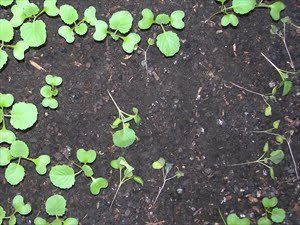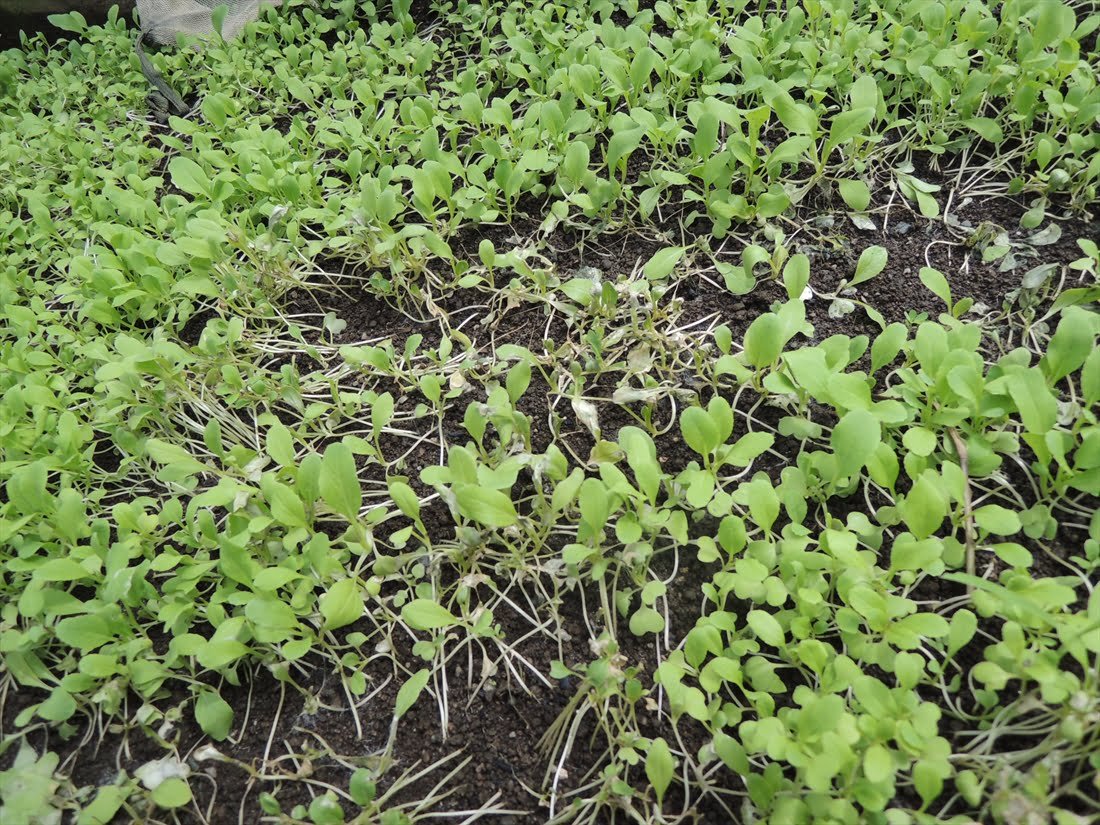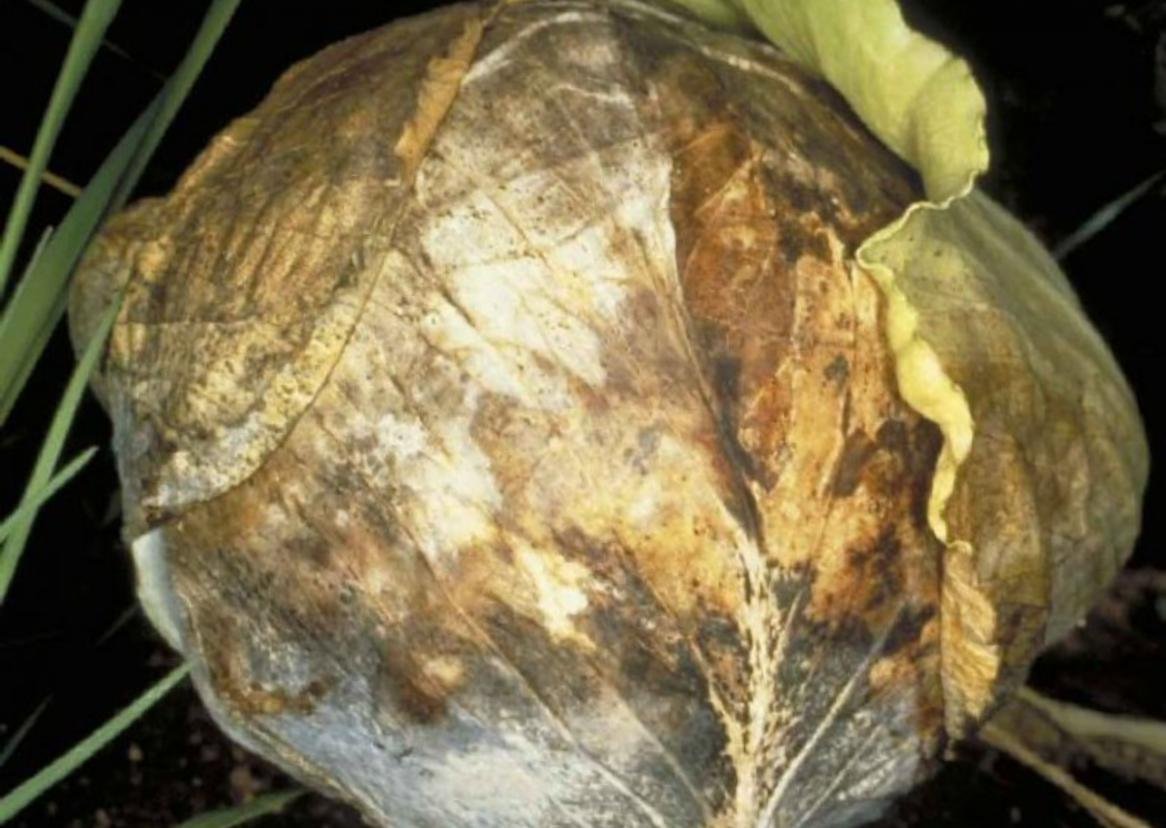Table of contents of the article
ToggleCabbage Damping Off disease is a fungal disease that affects cabbage plants in their early stages of growth and leads to crop failure. In this article from the “WORLD OF PLANTS” website, we discuss the most important symptoms of the disease and methods of prevention and control.
Introduction to Cabbage Damping Off
Damping off disease
Scientific name: Pythium spp
Type of disease: fungal
Among the most important diseases that cause major economic losses are beans, chickpeas, lentils, peas, soybeans, peanuts, and nightshade vegetables: tomatoes, potatoes, eggplant, cucumbers, cabbage, broccoli, tobacco, cotton, lettuce, sugar beets, rice, grains, and flax.
Symptoms of Cabbage Damping Off
Seeds rot in the soil.
Dark, water-soaked lesions at the base of the seedling stem.
Light, pale, mushroom-like growth covering the seedlings.
Seedling drop or death can occur in two stages during seedling growth: the first is pre-emergence and the second is post-emergence. The fungus colonizes the seeds immediately after sowing, causing seed rot and inhibiting germination at the pre-emergence stage. In the post-emergence stage, seedling growth is poor and the base of the stem begins to rot. The stems grow soft and thick with water-soaked, grey, brown or black lesions. Young plants or trees become yellow due to a lack of chlorophyll and begin to wilt and then fall over, looking as if they have been cut off at the base. White or gray mold-like growth also appears on dead plants or on the surface of the soil. Reseeding may be necessary when seedling loss is extensive.
Plants do not appear above the soil surface when the seeds are infected, which appears in the form of a decrease in the seed germination rate.
Yellowing of plants
Plants are stunted
Root and crown rot.
Ultimately, it causes the death of plants, and its infection is more severe in heavy # soils.
The fungus attacks the plant at its various stages of growth, infecting seeds, seedlings, and large plants on some branches or the entire plant and fruits.



The pathogen of Cabbage Damping Off
The disease is caused by a wide range of fungi
Rhizoctonia solani.
(phytoophthora, pythium, botrytis, fusarium) that cause Damping Off, which is Rhizoctonia, is the most important and common cause of the disease and constitutes 48% of the total fungi that cause Damping Off. It primarily attacks the roots and lower stems in the early stages of plant growth, and the symptoms vary depending on the plants
Cause of Cabbage Damping Off
Seedling drop and dieback can affect many crops, and is caused by fungi of the genus Pythium, which can live for several years in soil or plant residues. They thrive when the weather is warm and rainy, the soil is excessively moist and the plant density is high. Stressful plant conditions such as water soaking or high nitrogen use weaken plant vigor and conditions become favorable for disease development. The spores are spread by contaminated tools or equipment and mud on clothing or shoes. Although these fungi can attack crops during their entire life cycle, the stage of seed germination or seedling growth is most susceptible. The disease does not necessarily spread from one season to another in the same place, but rather appears when and where conditions become favorable for infection.
Suitable conditions for the spread of Cabbage Damping Off
Temperature is 25-30°C, and the ideal is 18°C, as it causes the greatest damage with a relative humidity of 50% and more.
Source of infection
Fungal mycelium is found in plant waste. The fungus is solid, dark brown stony bodies. When conditions are suitable for the disease, it germinates to produce mycelium in the soil and plant waste. It retains its vitality for several years and is transmitted by all of the following:
- Contaminated soil, found at a depth of 15-20 cm.
- Seeds.
- It is transmitted with rain, water movement, and agricultural tools.
- Heavy, poorly drained soils. The injury is severe.
- Wounds occur in the neck area of the plant.
- Deep planting of plants so that the stem neck is away from the soil surface.
Preventive management
This is done by following integrated management to prevent the disease, because once the infection occurs, it cannot be cured, by following agricultural methods that protect plants from infection, cultivating and dismantling the soil to facilitate the emergence of seedlings, and following the following:
- Using disinfected and highly vital seeds resulting from the first harvest.
- Planting disinfected seedlings.
- Agricultural cycle.
- Disposing of plant waste and sterilizing the soil.
- Reduce humidity, especially when planting and using drip irrigation.
- Planting on the southern side of the line, where there is greater exposure to sunlight.
- When planting with seeds, the planting depth should not exceed 5 cm, and when planting with seedlings, the neck of the stem should be on the surface of the soil and not planted deeply.
- Irrigating the soil before planting seeds helps reduce planting depth
- Do not plant seeds when the soil is cold (temperature less than 16°C).
- Adherence to agricultural dates and planting after the end of the cold wave.
Organic control
Biocides based on the fungi Trichoderma viridii, Beauveria fungi, Pseudomonas fluorescens and Bacillus mycobacteria can be used as a seed treatment or applied around the root zone at planting time to prevent or control the fungus at the pre-seedling stage. Preventive treatment of seeds using solutions containing copper fungicides, such as copper oxide or Bordeaux chloride mixture, may help reduce the incidence and severity of the disease in some cases. You can also use homemade solutions based on plant extracts of waterhemp that completely prevent fungal growth. Likewise, irrigation with smoke water prepared by burning plant materials and dissolving the smoke in water also has an effect on preventing the growth of fungi.
Chemical control
One of the following treatments should be used on the crop. When purchasing a product, ensure that the following active ingredients are written on the container label:
– Mancozeb 75.0WP
Metalaxyl 35.0 WS-
شروط الاستخدام
1-Apply the product 1 time
2-Do not use this product if the weather is windy or rainy, and application should be avoided during the hottest hours of the day.
3- Spraying
Recommendations
We recommend applying organic control in the early stages of the disease or when the crop is close to harvest. In the more advanced stages of the disease, please use chemical control. It is not recommended to mix or use different products at the same time.
Treatment of Cabbage Damping Off
1. Seed treatment
Vitafix 75% 2-3 g/kg seeds
Rayzolux 50% at a rate of 1.5 g/kg seeds.
Monserin 25% at a rate of 1 g/kg seeds.
Roverin 20% at a rate of 4 g/kg seeds.
2. In nurseries
One day before collecting the seedlings, irrigation is stopped, then Rezolex is sprayed, and then irrigation is carried out.
Disinfecting the roots of seedlings after uprooting up to the neck area of the plant with Prizolex at a concentration of 2% for a quarter of an hour
3. In the field
Spraying the plants 4 days after transplanting with Rezolex pesticide at a rate of 2 kg per dunum, and before spraying the plants with the fungicide, the leaves of the plants must be moistened with water by spraying at a rate of 2 m3 of water. Then spray again with water only, 4 m3, also on the plant after spraying the pesticide to prevent plant burns on the leaves.
Spraying is repeated after a month, taking into account spraying in the morning or evening when the temperature drops.
Moon Cut can be used for rhizoctonia
There are two quarrels and Maxim has a wide range of influence
The use of the Trichoderma harzianum fungus reduces the infection, as its use in field conditions contributed to reducing the infection by 86% from rhizoctonia infection and by 27-51% from root rot.
Written by dr.jenen othman
# References:
- [Ogoshi, Akira. “ECOLOGY AND PATHOGENICITY OF ANASTOMOSIS AND INTRASPECIFIC GROUPS OF.. RHIZOCTONIA SOLANI KUHN.” Annual Review of Phytopathology 25.125-43 (1987)]
- [Cubeta, M.A., and R. Vilgalys. “Population Biology of the Rhizoctonia Solani Complex.” Population Genetics of Soilborne Fungal Plant Pathogens 87.4 (1997): 480–84. The American Phytopathological Society. Web. 4 Oct. 2011.], The American Phytopathological Society.
- [Ceresini, Paulo. “Rhizoctonia solani.” Rhizoctonia solani. NC State University. Web. 04 November 2011 .], NC State University Rhizoctonia Solani.
- [“Rhizoctonia Diseases.” Michigan Potato Diseases. PS Wharton, Michigan State University, 2 May 2011. Web. 04 Oct. 2011. .], PS Wharton Michigan State University.
- Wiese, M. V. (1987). Compendium of wheat diseases. American Phytopathological Society. Pp. 124 pp.
- APSnet Education Center – Plant Disease Lessons – Rhizoctonia diseases of turfgrass – Pathogen Biology. Plant Pathology / Plant Disease Online – The American Phytopathological Society.
- [Uchida, Janice Y. “Rhizoctonia solani.” KnowledgeMaster. Web. 04 Oct. 2011. http://www.extento.hawaii.edu/kbase/crop/type/r_solani.htm.], Janice Uchilda Knowledge Master.
- [Anderson, Neil. “The Genetics and Pathology of Rhizoctonia solani.” Annual Review of Phytopathology 20.329-47 (1982): 331–38.]
- Molecular Plant Pathology (2013) 14(9), 910–922
- Cubeta MA, Thomas E, Dean RA, Jabaji S, Neate SM, Tavantzis S, Toda T, Vilgalys R, Bharathan N, Fedorova-Abrams N, Pakala SB, Pakala SM, Zafar N, Joardar V, Losada L, Nierman WC (2014). “Draft Genome Sequence of the Plant-Pathogenic Soil Fungus
- Rhizoctonia solani Anastomosis Group 3 Strain Rhs1AP”. Genome Announc. 2 (5): e01072–14. Doi:10.1128/genomeA.01072-14. PMC 4214984 Freely accessible. PMID 25359908.
- Wibberg D, Rupp O, Jelonek L, Kröber M, Verwaaijen B, Blom J, Winkler A, Goesmann A, Grosch R, Pühler A, Schlüter A (2015). “Improved genome sequence of the phytopathogenic fungus Rhizoctonia solani AG1-IB 7/3/14 as established by deep mate-pair sequencing on the MiSeq (Illumina) system.” J. Biotechnol. 203:19–21.




